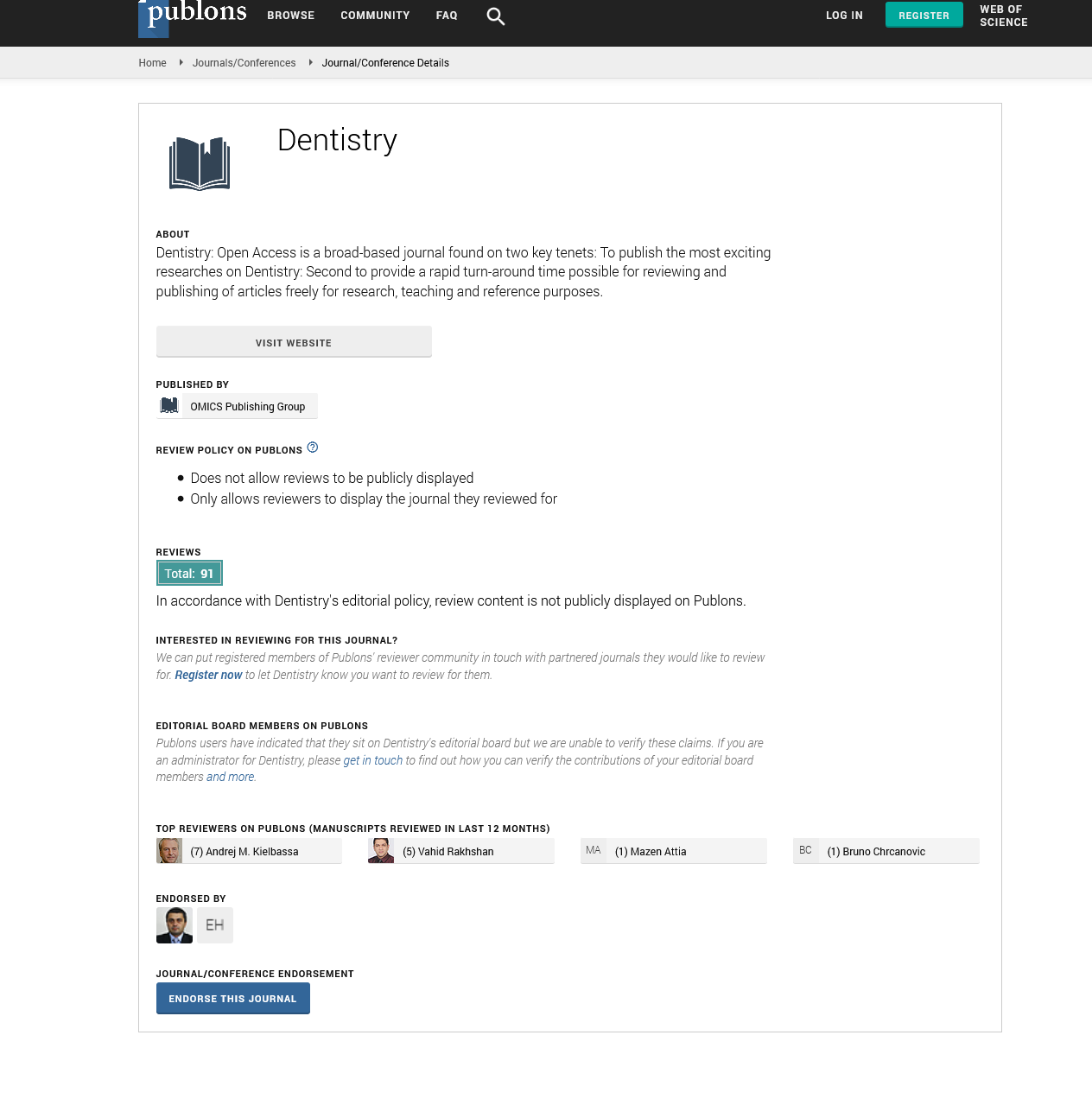Citations : 2345
Dentistry received 2345 citations as per Google Scholar report
Indexed In
- Genamics JournalSeek
- JournalTOCs
- CiteFactor
- Ulrich's Periodicals Directory
- RefSeek
- Hamdard University
- EBSCO A-Z
- Directory of Abstract Indexing for Journals
- OCLC- WorldCat
- Publons
- Geneva Foundation for Medical Education and Research
- Euro Pub
- Google Scholar
Useful Links
Share This Page
Journal Flyer

Open Access Journals
- Agri and Aquaculture
- Biochemistry
- Bioinformatics & Systems Biology
- Business & Management
- Chemistry
- Clinical Sciences
- Engineering
- Food & Nutrition
- General Science
- Genetics & Molecular Biology
- Immunology & Microbiology
- Medical Sciences
- Neuroscience & Psychology
- Nursing & Health Care
- Pharmaceutical Sciences
Commentary - (2025) Volume 15, Issue 1
The Impact of Fluoride on Tooth Surface Integrity in Erosive Conditions
Rayssa Steiger*Received: 25-Feb-2025, Manuscript No. DCR-25-28551; Editor assigned: 27-Feb-2025, Pre QC No. DCR-25-28551 (PQ); Reviewed: 13-Mar-2025, QC No. DCR-25-28551; Revised: 20-Mar-2025, Manuscript No. DCR-25-28551 (R); Published: 27-Mar-2025, DOI: 10.35248/2329-9088.25.15.715
Description
Dental erosion is a progressive loss of enamel due to chemical processes not involving bacterial activity. The impact of erosive agents, such as acidic beverages and gastric fluids, has been extensively studied. Abrasion, a mechanical wear process caused by external factors like toothbrushing, may exacerbate enamel loss when combined with erosion. Fluoride has been widely used in dental care to enhance enamel resistance and reduce mineral loss. However, its effectiveness in protecting enamel from erosion, especially in combination with abrasion, remains a subject of discussion.
Mechanism of action of fluoride in erosion prevention
Fluoride aids in enamel protection through several mechanisms. It facilitates the formation of a fluorapatite-like layer, which is less soluble in acidic environments compared to hydroxyapatite. Additionally, fluoride contributes to the remineralization process by promoting calcium and phosphate deposition. The efficacy of fluoride against erosion is influenced by factors such as concentration, formulation, frequency of application and exposure to additional protective agents.
Fluoride and erosion alone
Studies analyzing fluoride's effect on erosion alone indicate that fluoride-containing products provide a measurable reduction in enamel loss. However, the degree of protection varies, with formulations containing stannous fluoride and titanium tetrafluoride generally exhibiting better performance than sodium fluoride and amine fluoride. The presence of additional protective agents, such as Casein Phosphopeptide-Amorphous Calcium Phosphate (CPP-ACP), further enhances fluoride's ability to mitigate mineral loss.
Fluoride and combined erosion-abrasion
The effectiveness of fluoride in erosion-abrasion conditions is influenced by the mechanical forces exerted during toothbrushing. While fluoride treatments provide some level of protection, repeated mechanical action may compromise the integrity of the protective layer. Studies have reported that stannous fluoride and titanium tetrafluoride maintain superior resistance under these conditions due to their ability to form robust surface coatings. Sodium fluoride, though beneficial, tends to offer less resistance against abrasion, particularly when brushing forces are high.
Clinical implications
Understanding the effectiveness of different fluoride treatments is essential for developing targeted preventive strategies. Based on the findings.
For individuals at high risk of dental erosion: Titanium tetrafluoride and stannous fluoride-based treatments may be recommended due to their superior protective abilities.
For patients with erosion linked to dietary acids: Frequent application of fluoride-containing products, particularly those with additional remineralizing agents, could provide enhanced protection.
For those with erosion-abrasion concerns: Minimizing aggressive brushing techniques while using fluoride formulations that form durable protective layers can improve outcomes.
Titanium tetrafluoride and stannous fluoride emerge as the most effective formulations, offering greater protection than sodium fluoride and amine fluoride. By considering fluoride type, application method and mechanical factors, more effective preventive strategies can be implemented to mitigate the risk of dental erosion and associated abrasion in human enamel.
Citation: Steiger R (2025). The Impact of Fluoride on Tooth Surface Integrity in Erosive Conditions. J Dentistry. 15:715.
Copyright: © 2025 Steiger R. This is an open-access article distributed under the terms of the Creative Commons Attribution License, which permits unrestricted use, distribution, and reproduction in any medium, provided the original author and source are credited.

